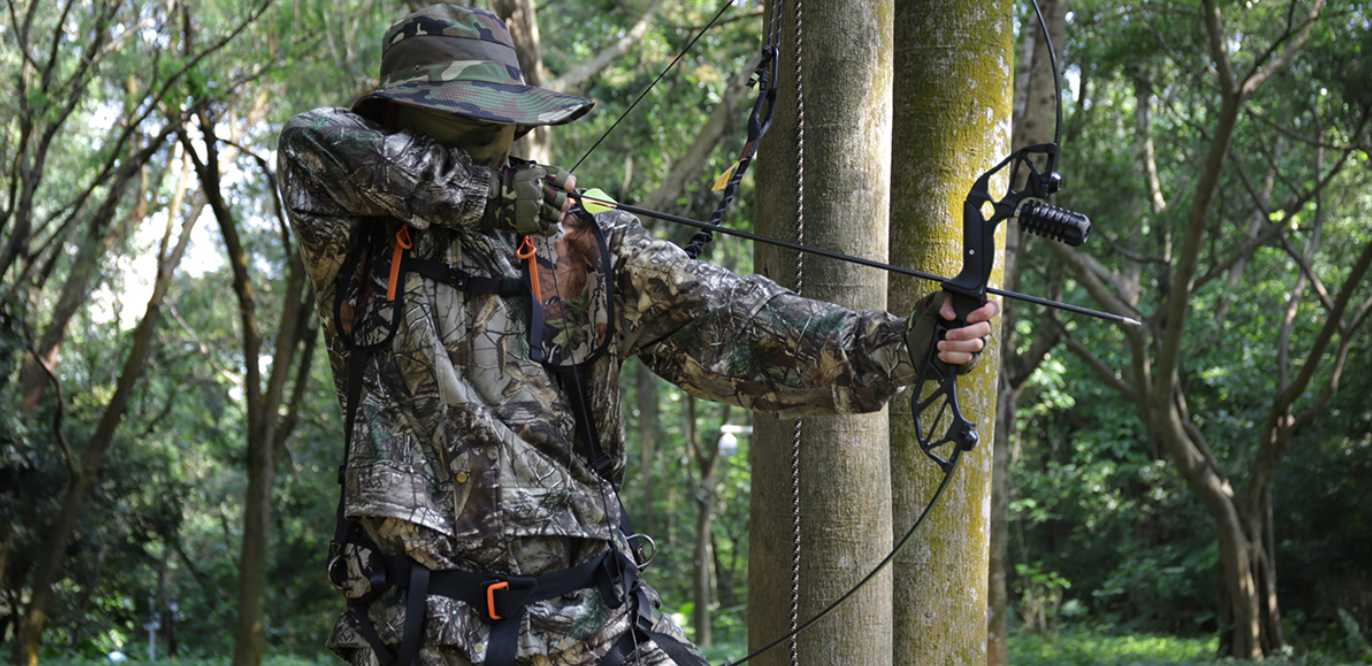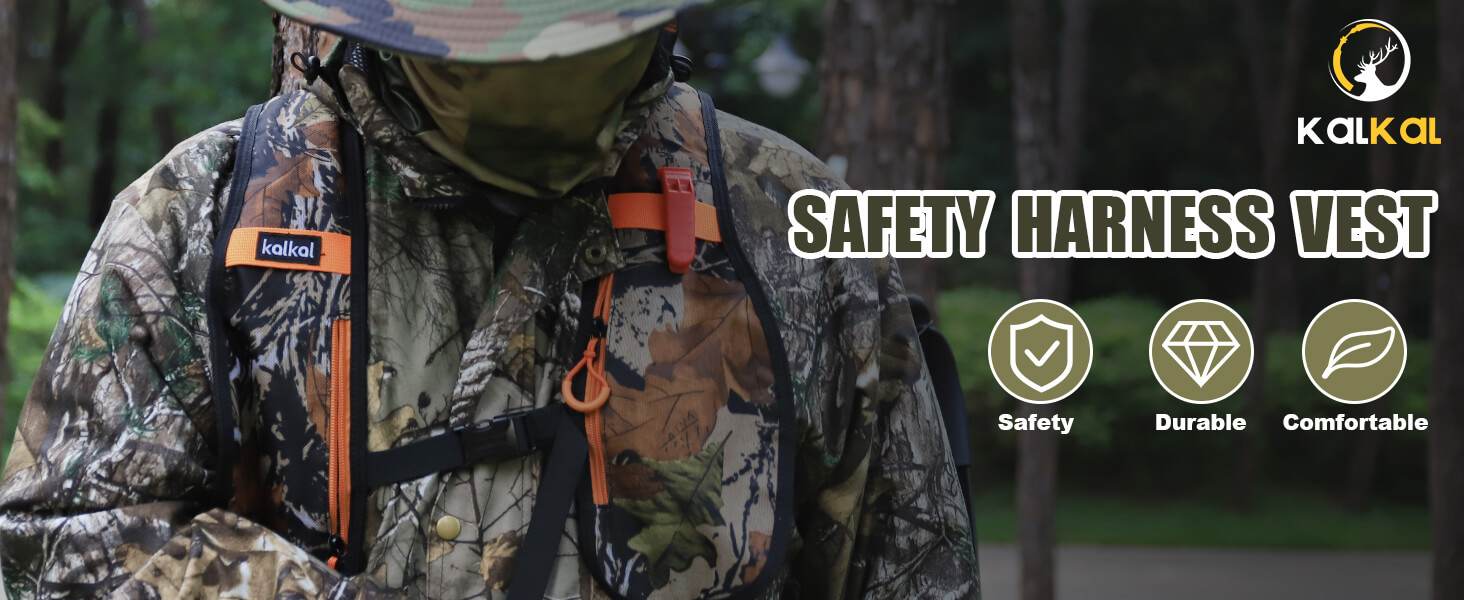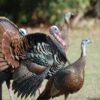Tree stand hunting presents an exciting view since the hunter is elevated from the ground; however, falling accidents are common and sometimes fatal. Fortunately, a tree stand safety harness can greatly lower the chances of this happening.
In this extensive guide, you will learn all that you need to know about tree stand safety harnesses. It will look at the various types available, how to select an appropriate one, the right way to use it, what not to do, and the essential care procedures.
By the end of the article, you’ll be well-equipped to guarantee a safe hunt from your tree stand.
What Are The Purpose of Treestand Harness?
Tree stand hunting can be fun as a form of recreation since it allows the hunter to have a vantage point to view the game and the comfort of having a good stand when hunting.
However, together with the opportunities, there are potential effects that are built into the very concept. Sitting for hours up in the tree equals to any other regular activity that has to be done with caution to avoid accidents.
Tree stand safety harnesses are the solution for that situation. They are part and parcel of your essential hunting gear, as crucial as your bow or rifle that can spare you from a critical mishap, let alone a fall.
Accidental falls are one of the major causes of hunters’ death or injury when they are on tree stands. It can be also considered as a kind of protective gear, similar to seat belts in the car.
- If anyone falls, a harness spreads force and holds one from falling, thus avoiding any mishap.
- A harness enables you to attach to a line that ensures that you are well secured to the tree. This is essential in climbing the tree, getting in and out of the stand, and while in the stand.
Different Types Of Safety Harness
There are three main types of tree stand safety harnesses:
- Full-body harness: This is the most common and recommended type. It offers complete upper and lower body support, distributing weight evenly in a fall.
- Chest harness: This offers some upper body support but lacks leg straps. It’s generally not recommended for tree stand hunting due to the limited fall protection.
- Waist belt: This only provides limited support around the waist and offers minimal fall protection. It should never be used for tree stand hunting.
How To Choose the Right Safety Harness for Tree Stand?
Selecting the right hunting safety harness isn’t a one-size-fits-all situation. Here’s what hunters should consider to ensure they have the best fit for their needs:
1. Fit and Comfort
- Size: Harnesses come in various sizes based on weight and chest circumference. A proper fit is crucial for safety and comfort. It should be snug but allow for freedom of movement. You should be able to slip your fingers, but not your fist, between the harness and your body.
- Adjustability: Look for harnesses with adjustable straps on the legs, chest, and shoulders for a customized fit. This ensures a secure feel and allows for layering clothing underneath.
- Comfort Features: Padding on the leg straps and back can make a big difference for long sits in the stand. Breathable materials also help with comfort during warmer weather.
2. Safety Features
- Weight Capacity: Ensure the harness is rated for your weight, including any gear you’ll be carrying.
- Durability: Look for harnesses constructed with strong, lightweight materials like nylon webbing and metal buckles.
- Certifications: Choose a harness that meets or exceeds safety standards set by organizations like the Tree stand Manufacturers Association (TMA).
3. Type of Hunting
- Style: Consider your preferred hunting style. If you’re a very active hunter who needs to move around a lot in the stand, a lighter, more minimalist harness might be suitable. For longer sits, a harness with more padding might be preferred.
- Climbing Method: If you use climbing sticks to access your stand, a harness with a lineman’s climbing strap attachment point is a good option.
4. Additional Considerations
- Lifeline: Many harnesses don’t include a lifeline (tether). Purchase a separate one rated for your weight and ensure it’s compatible with your harness.
- Practice: Before heading out to hunt, practice using your harness at home. Get comfortable with attaching and detaching the lifeline, adjusting the straps, and suspending yourself safely.
How To Use a Tree Stand Safety Harness?
Always remember that safety is the top priority. Knowing how to properly wear and use your safety harness is just as important as choosing the right one. Here’s a breakdown of the steps involved:
Putting on the Harness Correctly
- Don the harness: Start with the legs and buckle the leg straps around your thighs. Ensure they’re snug but not restricting circulation.
- Adjust the torso: Locate the chest and shoulder straps and adjust them for a secure, comfortable fit. You should be able to move freely, but the harness shouldn’t be loose.
- Connect the tether: Attach the carabiner on the lifeline (purchased separately and weight-rated for you) to the designated attachment point on the harness, usually a D-ring on the chest or back.
Safety Checks Before Climbing
- Double-check connections: Visually confirm that all buckles, straps, and the carabiner connecting the lifeline are securely fastened.
- Test the tether: While standing on the ground, slowly lean back slightly to ensure the tether catches and suspends your weight.
How to Use Kalkal Treestan Safety Harness
Common Mistakes to Avoid When Using Safety Harness
Even with a safety harness, mistakes can happen. You should know some common ones to avoid during tree stand hunting:
1. Harness Misuse
- Wrong Harness Type: Using a chest harness or waist belt instead of a full-body harness. These offer minimal fall protection and aren’t suitable for tree stand hunting.
- Improper Fit: A harness that’s too loose can slip or fail to distribute impact properly in a fall. Conversely, one that’s too tight can be uncomfortable and restrict movement. What’s more, each harness has its capacity so make sure to buy the one that can carry your weight.
- Incorrect Attachment: Not attaching the carabiner on your lifeline to the designated D-ring on the harness. This can compromise its effectiveness.
- Forgetting to Connect: Failing to connect your lifeline to a secure anchor point on the tree throughout your time in the stand. This negates the harness’s purpose.
2. Neglecting Safety Practices
- Not Using Three Points of Contact: Climbing or descending the tree stand without maintaining three points of contact at all times increases the risk of slips and falls.
- Making Risky Movements: Sudden movements or reaching for something out of reach can cause you to lose balance.
- Ignoring Lifeline Length: Using a lifeline that’s too short can result in a dangerous fall if it doesn’t allow sufficient slack for movement in the stand.
3. Improper Care and Maintenance
- Not Inspecting Your Harness: Before each use, thoroughly inspect your harness for any signs of damage like worn webbing, ripped seams, or faulty buckles. A compromised harness can fail you when you need it most.
- Failing to Replace a Worn Harness: Harnesses have a lifespan and can weaken over time. Replace your harness if you notice any concerning signs of wear or if it’s several years old.
Maintenance Of the Safety Harness
Before going into the maintenance, the first question must be triggering in your mind:
Does tree stand harnesses have a life cycle?
Yes, tree stand safety harnesses do have a lifespan. Even though they’re built for durability, they can weaken over time due to wear and tear, exposure to the elements, or UV rays.
How to inspect and maintain Harness?
Here’s how to properly check and maintain your harness to ensure it remains in its best condition:
Follow Manufacturer’s Recommendations: Most manufacturers recommend replacing your harness every 5 years under typical use. However, this can vary depending on the brand and frequency of use. Check your specific harness manual for recommended replacement intervals.
Pay Attention to Signs of Wear: Don’t rely solely on age. Regularly inspect your harness for any telltale signs of wear and tear that might warrant earlier replacement, such as:
- Frayed or ripped webbing
- Cracked or broken buckles
- Loose stitching
- Worn or damaged padding
- Weakened metal components
Properly clean and store
- Pre-Season Check: Before each hunting season, conduct a thorough visual inspection of your harness. Follow the manufacturer’s instructions for any specific maintenance procedures.
- Cleaning: Clean your harness with mild soap and water to remove dirt, sweat, or debris. Allow it to air dry completely before storing. Never use harsh chemicals or bleach.
- Storage: Store your harness in a cool, dry place away from direct sunlight and extreme temperatures. Avoid storing it compressed or folded in a way that can cause permanent creases or damage.
Conclusion
Tree stand hunting is one of the most exciting hunting methods, nonetheless, safety should be maximized. With this inference, one can compare a tree stand safety harness to one’s weapon, making it an essential piece of equipment. Select the correct harness that is comfortable for you and has the number of needed rings.
Know how to wear it properly, how to inspect or when to replace it. If you follow the above-mentioned instructions and take proper precautions, you can reduce your chances of an accident and focus on the fun of hunting from a tree stand.





















Leave a reply